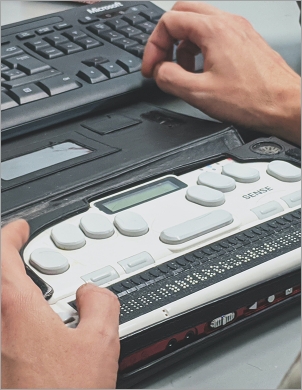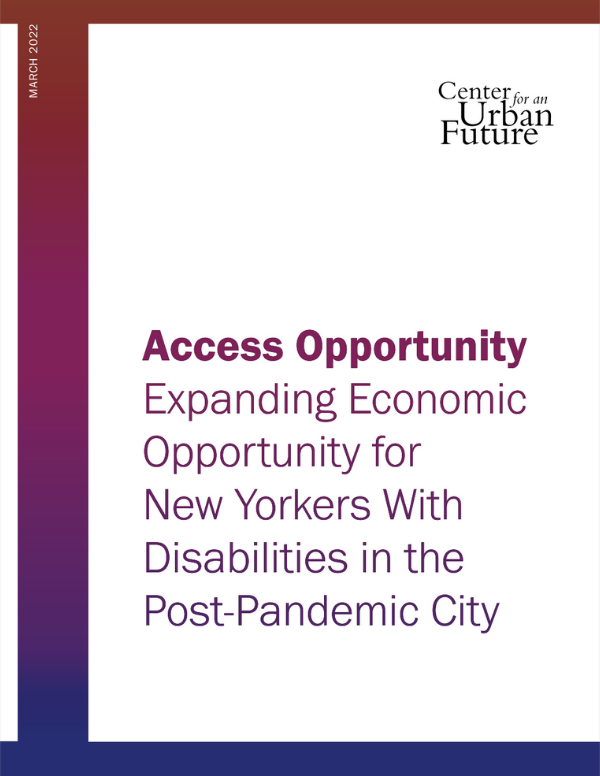Amid a pandemic that has taken a disproportionate toll on the most vulnerable New Yorkers, this report finds that the economic impact on New Yorkers with disabilities has been especially severe.
Even before the pandemic hit, just 35 percent of working-age New Yorkers with disabilities were employed, and more than one-third were experiencing poverty. But over the past nine months, these economic challenges have been magnified. Interviews with more than a dozen direct service providers and advocacy organizations across the five boroughs reveal the massive economic hardship that New Yorkers with disabilities are enduring—including near-total job losses and unending furloughs—as well as the fiscal cliff facing the organizations that serve them.1
Five of the organizations interviewed for this report say at least half of their clients with disabilities have lost their jobs or been furloughed and remain unemployed because of the pandemic, with some reporting near-total job losses among New Yorkers with disabilities. At the JCC Manhattan Center for Special Needs, about 70 percent of its clients with disabilities were laid off, and around 20 percent were furloughed. The Institute for Career Development (ICD), which helps New Yorkers with disabilities access employment, reports 75 percent or more of its clients in full-time employment lost their jobs or saw a reduction in hours. And even as employment has shown modest signs of recovery citywide, around 60 to 70 percent of Job Path NYC’s clients—people with autism and other developmental disabilities—remained furloughed, more than eight months after lockdown. (Interviews for this report were conducted in October and November of 2020.)
The pandemic has only magnified these economic challenges, in large part because many of the jobs and industries that have provided an entryway to the workforce for New Yorkers with disabilities have experienced the steepest losses. “Individuals with disabilities are usually the first laid off and the last to be rehired” in an economic downturn, says Susanne Bruyère, disability researcher and director of the Yang-Tan Institute on Employment and Disability at Cornell University. But she says that the specific impacts of this crisis are resulting in extreme challenges for New Yorkers with disabilities. “People with disabilities have always been in lower-end jobs, in part-time jobs, jobs that you find in service industries like restaurants and hospitality, but also nursing homes and hotels. And those industries have been hit really hard.”
Even in a growing economy, New Yorkers with disabilities faced alarmingly long odds of achieving stable employment. In fact, the unemployment rate for working-age New Yorkers with disabilities in 2017 (14.7 percent) was higher than the citywide unemployment rate in October 2020 (13.2 percent). For many New Yorkers with disabilities, Great Depression–level unemployment was already routine. But while other dimensions of this ongoing crisis have received significant attention from policymakers and in the media, the enormous economic challenges facing New Yorkers with disabilities have largely flown under the radar.2
“The disproportionately low rate of participation in the labor market for people with disabilities is a huge problem,” says Julie Christensen, director of policy and advocacy from the Association of People Supporting Employment First (APSE), a national organization that supports employment opportunities for people with disabilities. “And we have not really made progress in the last 30 years.”
Meanwhile, many of the organizations that serve New Yorkers with disabilities have sustained steep financial losses, with some teetering on the edge of fiscal insolvency. Organizations have reported the loss of millions of dollars in expected revenue while incurring major unanticipated costs for technology, personal protective equipment, cleaning, and other needs. Among the organizations interviewed for this report, all are reporting revenue declines in 2020 of between 20 and 66 percent. For instance, the Institute for Career Development estimates that contract revenue will decrease by 66 percent, and that total revenue will plunge by 40 percent from the previous fiscal year to this one. A recent survey of 34 New York-based agencies serving people with disabilities by a statewide coalition underscores this pattern, finding that these organizations incurred more than $75 million in unanticipated costs due to the pandemic, and lost almost $63 million in total revenue since March.3
At a time when programs and services supporting employment opportunities for New Yorkers with disabilities will be needed more than ever, their very existence is threatened. “The infrastructure, the network of community-based organizations that do training and employment for people with disabilities is at real risk,” says Susan Scheer, CEO of the Institute for Career Development. “And there may not be enough provider agencies there when people are ready to go back to work and when the jobs start picking up.”
This report—generously supported by Citi and Kessler Foundation—documents the unprecedented financial and employment challenges facing New Yorkers with disabilities during this crisis, as well as the serious vulnerabilities of the organizations that serve them.
Among our key findings on income and employment losses for New Yorkers with disabilities:
- Five of the organizations interviewed for this report say at least half of their clients with disabilities have lost their jobs or been furloughed and remain unemployed because of the pandemic, with some reporting near-total job losses among New Yorkers with disabilities.
- 75 percent or more of the Institute for Career Development clients who had full-time employment either lost their jobs or had their hours reduced. At least 400 clients lost their primary source of income.
- About 70 percent of JCC Manhattan Center for Special Needs clients were laid off, and 20 percent were furloughed.
- Around 60 to 70 percent of Job Path NYC’s clients were still furloughed more than eight months after lockdown.
- Over half of the 100 people enrolled in Bronx Independent Living Services’ COVID-19 relief program have either lost their jobs or had their hours reduced.
- About 1,500 community members of the Center for Independence of the Disabled NY (CIDNY) lost their primary source of income.
- The Association of People Supporting Employment First (APSE), a national organization that supports employment opportunities for people with disabilities, conducted a survey with over 20 New York providers; of those organizations, about 60 percent report that their clients have lost employment (490 clients lost jobs in total).4
Among our key findings on the economic impact of the crisis on organizations serving New Yorkers with disabilities:
- Job Path NYC reports a 30 to 40 percent decline in expected fundraising revenue due to in large part to a dip in giving caused by the pandemic.
- VISIONS, an organization providing services to people who are blind or have low vision, lost a state contract worth $500,000 due to the pandemic and estimates another $500,000 in lost or delayed revenue for its in-home and community training programs, which have been canceled or postponed. The organization estimates incurring between $250,000 and $300,000 in unanticipated labor, technology, PPE, cleaning and other costs from March through December.
- Institute for Career Development estimates that the organization projected a 66 percent decline in contract revenue in 2020 and a 40 percent decline in total revenue. The organization also spent about $50,000 to $75,000 to purchase computers, tablets, hotspots, and Zoom licenses for clients and staff, to enable remote services.
- New York Foundling, which provides support services to people with developmental disabilities, expects to lose $120,000 in projected fundraising in 2020 and $480,000 from vacancies in their residential program, due to the pandemic. The organization also estimates that it will incur $700,000 in unanticipated costs for PPE and cleaning equipment.
On top of the ongoing economic pain felt by New Yorkers with disabilities and organizations serving them, looming cuts to city and state programs could bring new challenges to the organizations best positioned to provide employment opportunities and aid to New Yorkers with disabilities on the long road to recovery. New York State plans to cut agency contracts by 20 percent, which will directly reduce available funding for supportive services. Cuts to providers of services to disabled New Yorkers have been even steeper: New York State’s Office for People With Developmental Disabilities (OPWDD) has reduced the residential reimbursement rate by 50 percent for clients who live at home or in a hospital, nursing home, or rehabilitation facility, even if the provider’s costs remain the same.
Organizations are also facing challenges due to COVID-caused government slowdowns. A dramatic slowdown in referrals from state programs like ACCES-VR (Adult Career and Continuing Ed Services Vocational Rehabilitation) at the height of the pandemic deprived organizations of much-needed funding linked to job training and placement, according to several organizations interviewed for this report. In fact, over 80 percent of providers surveyed by APSE reported a decrease in vocational rehabilitation funding. The Institute for Career Development saw virtually no referrals at all from April to July for its employment programs, and the current referral rate remains nearly 60 percent lower than in 2019.5
Still, the massive disruption caused by the pandemic could generate new opportunities for New Yorkers with disabilities as remote work and virtual programming becomes more normalized across the economy—but only if policymakers, philanthropy, and the private sector seize the moment to harness them.
“One of the ironies of this moment is that a lot of innovations or opportunities that were long advocated for by people with disabilities are now being recognized,” says Susan Scheer of the Institute for Career Development. “Employment makes a difference in people’s lives unlike any other policy intervention I’ve seen. We have a unique opportunity to work together on rebuilding the economy and making sure that equity and inclusion are part of the process from the start.”
This report details the economic challenges facing New Yorkers with disabilities in this time of crisis, as well as the financial impact on direct service providers. Based on interviews with the leaders of more than a dozen organizations that serve, advocate for, and employ New Yorkers with disabilities across the five boroughs, this report also provides recommendations for city and state policymakers to ensure that New Yorkers with disabilities are included in any effort to cultivate a lasting economic recovery.
New Yorkers with disabilities have experienced major employment losses or reduced hours, and few jobs have returned.
- 75 percent or more of the Institute for Career Development clients who had full-time employment either lost their jobs or had their hours reduced. At least 400 clients lost their primary source of income.
- 70 percent of JCC Manhattan’s Center for Special Needs community members were laid off, and around 20 percent were furloughed.
- About 1,500 clients of the Center for Independence of the Disabled NY (CIDNY), which provides services and education to help people with disabilities direct their own lives, lost their primary source of income.
- Roughly 30 percent of the 100 people in Goodwill’s supported employment program lost their jobs.
- 55 percent of clients enrolled in Bronx Independent Living Services’ COVID-19 relief program have either lost their jobs or had their hours reduced.
- About 25 percent of NY Foundling’s clients with disabilities who were employed experienced a reduction in hours.
- Of the 85 percent of Job Path NYC’s clients who were furloughed in the beginning of the pandemic, about 60 to 70 percent are still furloughed.
- “For many of the people we hire, this has been their first job,” says Jean-Emmanuel Shein, director of global corporate social responsibility at UNIQLO, which has a corporate policy of hiring people with disabilities in all retail locations. “If they’re let go, it’s not as if they’re just starting again from square one—they’re even further behind. For some, it may end up feeling like the job market isn’t for them, making it even harder to get back up and fight again.”
Direct service providers report losing 20 to 66 percent of expected revenues in 2020 due to canceled fundraising events and a major reduction in government contracts, while incurring millions of dollars in unanticipated costs due to the pandemic.
- Institute for Career Development predicts contract revenue will decrease by two-thirds, and that total revenue declined by 40 percent since the previous fiscal year. The organization also spent about $50,000 to $75,000 to purchase computers, tablets, hotspots, and Zoom licenses for clients and staff. The organization’s employment program is seeing just 40 percent of their typical referral rate.
- Job Path NYC reports that fundraising revenue has decreased in 2020 by 30 to 40 percent.
- VISIONS canceled four events that, in total, usually raise $175,000 to $200,000. It also lost $500,000 on a state contract for residential vocational rehabilitation center programs that were canceled and another $500,000 in lost or delayed revenue for in-home and community training that was canceled from March to June. The provider estimates unanticipated labor, technology, PPE, cleaning and other costs between March and December to amount to $250,000 to $300,000.
- Community Resources Staten Island, an organization providing comprehensive services to people with intellectual and developmental disabilities, reports losing about 70 percent, or around $83,250 to $88,250, in expected revenue due to canceled fundraisers. None of the funding proposals the provider sent to private foundations have been successful.
- NY Foundling expects to lose $120,000 due to canceled fundraising events. The organization estimates a decline in revenue of $480,000 due to vacancies in their residential program. It also projects $700,000 in costs for PPE and cleaning equipment.
- Bronx Independent Living Services, which provides people with disabilities access to education, job training, and other resources, predicts that it will end 2020 with as much as a 20 percent loss in revenue. They have not received about 25 percent of their grants and $170,000 of their advances for the new fiscal year.
- Barrier Free Living, which provides comprehensive support services for survivors of domestic violence with disabilities, has been owed almost $180,000 in reimbursements from the state for over five months.
- CIDNY incurred $60,000 to $75,000 in unexpected technology costs in order to set up remote services and programming.
Access to resources such as technology and digital skills training, food, and housing continues to present challenges for New Yorkers with disabilities.
- Community Resources Staten Island has only been able to reach 60 percent of the clients enrolled in its services since the pandemic hit, often because clients lack technology at home or need one-on-one in-person assistance to use it.
- About half of the older adults 55 years or older that VISIONS serves do not have computers or Internet at home and have been unable to access remote or virtual services.
- The Institute for Career Development reports that fully 95 percent of the organization’s clients come from low-income households and lack digital fluency and/or access to broadband and Internet-connected devices at home. Now that the pandemic has forced the organization to move to remote learning, student retention has been a struggle. “When we went online in April, 25 percent of our active students in training dropped out because of their fear or lack of comfort with tech and learning online,” says CEO Susan Scheer.
- The Institute for Career Development also gave out more than $25,000 in direct cash assistance to about 70 people, and the vast majority used that money for food.
- More than 100 families served by Bronx Independent Living Services reported challenges accessing enough food. The organization either buys food for them, helps them enroll in the city’s free food programs, or refers them to partner organizations.
The pandemic has forced direct service providers to cancel or scale back programming, limiting the number of New Yorkers with disabilities who can access these vital supports.
- Community Resources Staten Island has been forced to cancel all of its supported employment programming.
- The Institute for Career Development suspended or postponed certain services until August, when job training and career assessments that must be delivered in-person resumed at no more than 50 percent capacity.
- In mid-March, 100 percent of VISIONS programming was canceled, and staff only had check-in calls with clients for urgent needs like food. By mid-April, the organization restarted with 50 remote classes for older adults, but their training programs for all ages remained canceled until July. VISIONS was only able to reach 200 of its 800 residential services clients in person, mostly due to their fears about virus exposure. VISIONS projected serving 400 fewer blind people and their caregivers in 2020.
- Over 25 percent of NY Foundling’s community members are no longer receiving regular programming due to the disruption caused by COVID.
- Barrier Free Living’s non-residential clientele dropped to about 80 individuals at the height of the pandemic, down from over 150. By mid-October clientele was still 25 percent below normal. “Many of the people we work with were sheltered with their abuser, which made contact impossible,” says Paul Feuerstein, the organization’s president and CEO.
- Bronx Independent Living Services lost roughly 40 percent of their clientele due to funding and staff cuts. It expects that the total number of its community members will decrease from 2,000 to 1,200 to 1,300 for 2020.
Seizing the opportunity to include New Yorkers with disabilities in the city’s economic recovery
The mass shift to remote work and virtual training underway right now presents an enormous opportunity to fundamentally expand access to competitive employment for New Yorkers with disabilities and help spur a far more inclusive recovery. Julie Christensen of APSE says the normalization of working from home has the potential to significantly expand work opportunities for people with disabilities.
“This whole map migration to virtual and remote communication has opened up a whole new way of thinking about job opportunities for people with disabilities that have been denied previously,” says Christiansen.
In the short term, direct service providers see the potential to cultivate new employment opportunities for people with disabilities focused on contributing to New York’s recovery efforts, although these jobs carry health risks. For instance, providers including ICD’s Susan Scheer cite the growth in custodial jobs fueled by the pandemic response, and training programs aligned with these jobs already exist. “One bright spot has been opportunities for cleaning work, including on the city’s subways,” says Scheer.
Providers have also seized new employment opportunities in contract tracing, local PPE manufacturing, and online retail fulfillment. “We have had success in placing blind people in jobs that are specific to the pandemic such as contact tracers and warehouse positions for companies like Amazon,” says Nancy Miller, executive director and CEO of VISIONS. “There are some factory jobs that manufacture PPE that have actually expanded job opportunities for blind workers throughout New York State.”
But to reconnect New Yorkers with disabilities to the workforce—and realize the larger opportunity that the shift to remote work and training provides—New York policymakers, philanthropy, and employers will need to take action now. New Yorkers with disabilities are experiencing unprecedented job losses and unending furloughs. Many of the community-based organizations serving New Yorkers with disabilities are facing fiscal crisis, including major disruptions and funding losses for programs that support employment. Too many individuals with disabilities are on the wrong side of the digital divide. Relatively few job training, upskilling, and workforce development programs are accessible to New Yorkers with disabilities. And employers are understandably more focused on salvaging their businesses rather than thinking creatively about how a more inclusive and accessible workplace can help. But by acting now, New York can take advantage of the unique opportunities that this current moment presents and help ensure that New Yorkers with disabilities are no longer among the first to suffer the economic impact of a crisis and the last to benefit from a rebound.
What New York City and State can do now to support an inclusive recovery for people with disabilities
Existing city programs to support employment for people with disabilities have provided valuable assistance both before and amid the COVID-19 crisis. For example, NYC: ATWORK, an employment program run by the Mayor's Office for People with Disabilities (MOPD), has continued to help connect job-seeking New Yorkers with disabilities to employment in the public and private sectors, and has moved its engagement process online. But ensuring an economic recovery that is inclusive to New Yorkers with disabilities will require bold new commitments and investments at both the city and state level.
Set clear goals to hire and retain New Yorkers with disabilities and develop new incentives to encourage rehiring. To ensure that New Yorkers with disabilities are included in the city’s difficult economic recovery, policymakers should establish statewide goals for hiring and retaining New Yorkers with disabilities—including hiring for COVID-response jobs like contract tracers, cleaners, and testing site workers. Policymakers should consider a package of incentives designed to encourage more businesses to rehire New Yorkers with disabilities, including tax credits, temporary wage subsidies, and partial insurance coverage. City and state government can continue to expand opportunities by working with MOPD and the Department of Citywide Administrative Services (NYCDCAS) to hire even more New Yorkers with disabilities through the 55-a program, specifically taking advantage of roles that now accommodate remote work. "I think that the key is really employment," says Brett Eisenberg, executive director of Bronx Independent Living Services. "I think that the government can hopefully lead by example, whether it's the state or the federal level, and hire more people with disabilities that can work remotely and also create programs that encourage that."
Invest in skills-building infrastructure accessible to New Yorkers with disabilities, including job and technology training programs that can unlock remote work opportunities. As opportunities for remote employment grow, New York should ensure that organizations focused on preparing New Yorkers with disabilities for jobs have the resources needed to succeed. Equally important, New York should help high quality job training and skills-building organizations that serve the general population to build accessibility into their programs and services. City and state government should create an emergency loan program to shore up the finances of training providers and invest in scaling up training programs for remote work while expanding access to assistive technology for specific disabilities. The city can build on the success of NYC: ATWORK's AbilITy Cisco Academy at ICD, the first fully-accessible computer networking certification program for New Yorkers with disabilities, which is now on its fourth 16-person cohort. City and state leaders should set a goal of developing another 50 accessible training courses—in partnership with workforce organizations, employers, and philanthropy—in high-growth fields like tech, healthcare, and the creative economy, ensuring that these pathways are open as the economy begins to recover.
Eliminate the benefits cliff disincentivizing employment opportunities. New Yorkers with disabilities are often forced to choose between keeping their public benefits and holding a steady job, which disincentivizes work even in better economic times. Most New Yorkers with disabilities rely on Supplemental Security Income (SSI) of roughly $10,000 a year, along with Medicaid. Though these benefits are far from a living wage, gaining full-time employment would mean losing this crucial safety net—a dangerous trade-off at a time when employment feels highly insecure. New York should eliminate asset limits for programs it controls, advocate for the federal government to do the same, and make it easier for workers with disabilities to access flexible programs like the Medicaid Buy-in Plan. “You should not have to choose between your health and employment,” says Scheer of ICD. “Allowing people the maximum flexibility to work and still maintain health insurance coverage is critical.”
Notes
1. Office of the New York State Comptroller. Employment Trends for People with Disabilities in New York City, October 2019. Retrieved from https://www.osc.state.ny.us/files/reports/osdc/pdf/report-7-2020.pdf
2. Ibid.
3. New York Disability Advocates, New York. NYDA Financial Survey through 5/31/20.
4. Association of People Supporting Employment First. Impact of COVID-19 on Disability Employment Services and Outcomes. Retrieved from https://apse.org/covid-19-impact-survey/
5. Ibid.





